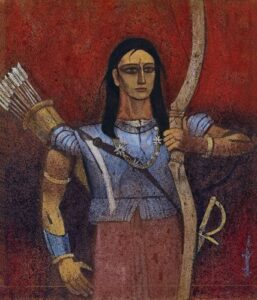Sunny Chandiramani
A true maestro whose work left an indelible mark on the world of modern Indian art, Ganesh Pyne was an artistic prodigy whose genius lay in his ability to blend the realms of reality and fantasy seamlessly.
His hauntingly beautiful paintings often depicted mythical and mystical subjects, exploring the human condition, mortality, and the intricacies of life. His oeuvre, predominantly characterised by dark and enigmatic imagery, earned him the reputation of being a master of the macabre.

The artist was born in Kolkata in 1937 during the tempestuous time preceding India’s independence and partition. Bearing witness to mayhem and death had a huge impact on the young Ganesh Pyne. ‘I was shaken by the sight,’ he stated once. ‘Since then, I have been obsessed with the dark world,’ recalled the artist once. He began sketching and doodling right from his childhood. Upon completing his education, he enrolled at the Government College of Art & Craft in Calcutta and graduated in 1959.
During his early years, Pyne was greatly influenced by the brothers Abanindranath and Gaganendranath Tagore. After graduating from Art College, he made the major decision of not going in for a full-time job. In 1963, he joined the recently established Society of Contemporary Artists, becoming an active member of the organisation.
The artist started his career painting water colours and monochrome renditions of wayside temples and glorious mornings.
Without a doubt, Ganesh Pyne’s water colour work titled Thug from the year 1955 is one of his most important early works. The stance of the ‘Thug’ exemplifies in-depth anatomical and posture understanding, the exact, precise angle of the nape, the neck upright with the air of an invader, a gesture which is extremely integral given the protagonist is a Thug.
In just two years, a distinct shift in style and vision occurred in Ganesh Pyne’s oeuvre. While he continued to work with watercolour, the subject matter, execution, and imagery underwent a significant transformation, establishing a new and separate pictorial and contextual space. A 1957 painting titled Raktakarabi showcases this shift and reflects a poignant element that had infiltrated Pyne’s imaginative realm, despite his young age of 20.
In the mid-1960s, Pyne transitioned from using watercolour to experimenting with gouache and tempera. The figures in his paintings started incorporating a skeletal element, while the animals depicted began revealing their fangs and claws. These creatures were portrayed as either predators or victims, evoking a sense of primal tension.
A subject that first appeared in his paintings in the 1960s, the Ape/Monkey series was a departure from his early focus on mythological folklore and the supernatural. The theme that he continually explored throughout his career. The simian figures, presented in different contexts and guises, are rendered with great attention to detail. The expressive faces and postures suggest a range of emotions, from playfulness to fear.
To prepare his canvases, he meticulously applied numerous layers of translucent colours, expertly smoothing them to achieve a delicate and translucent effect. This technique endowed his artworks with a captivating touch of transparency.
This quintessential, Ganesh Pyne – tempera on canvas creation, titled The Head from the year 1977 depicts a solitary figure, deep in contemplation with a penetrating gaze. The recurring motif of the ape or monkey is undoubtedly a subject of great importance to the artist.
Another similar work titled The Clown was executed in 2003. The face of the subject is decorated with clown paint while the figure is bent on its knees and has a rope around its neck.
The artist touched upon an array of subjects too during the mature phase of his career. Titled Abhimanyu, it is a depiction of the young war hero executed in 2000. Reticent by nature himself, he chose peripheral characters whom he could relate with and chronicled their achievements.
To place a finger on the epoch of Ganesh Pyne’s art could catapult the most analytical mind and discerning pair of eyes into a state of contemplation. Simply, owing to the fact that each and every phase pronounces a silent exuberance.
In the past decades, works by artist Ganesh Pyne have been showcased in several important exhibitions and shows in India as well as abroad.
Sunny Chandiramani is Senior Vice President at AstaGuru Auction House